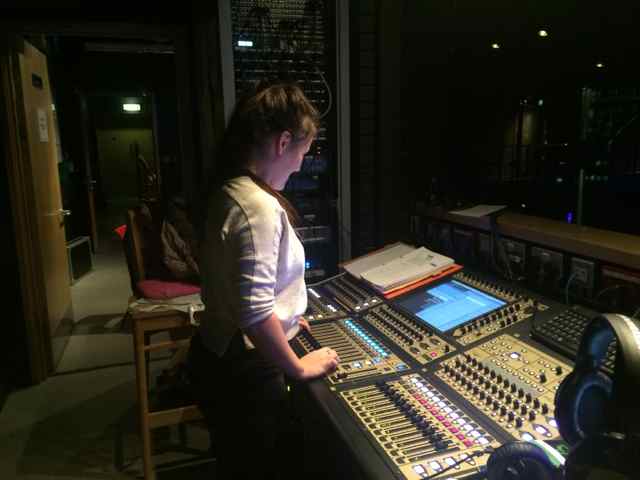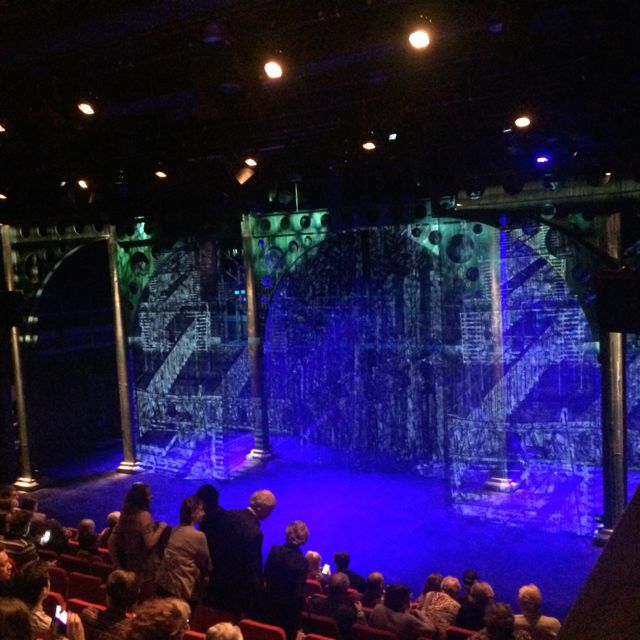GHOST is a timeless fantasy about the power of love. Walking back to their apartment one night, Sam and Molly are mugged, leaving Sam murdered on a dark street. Sam is trapped as a ghost between this world and the next and unable to leave Molly who he learns is in grave danger. With the help of a phony storefront psychic, Oda Mae Brown, Sam tries to communicate with Molly in the hope of saving and protecting her.
I knew the musical Ghost would be fun to do. There would be loads to play with; the ghost battles and the deaths. Add a band and loads of comedy and I knew this would be a great show.
Sword Fights – Electricity – Demons – Trains- What’s Not to Like
SoundScape
I wanted the sound of the ghosts interacting with each other to be a strong sound. It needed to be full of energy and still have an element of impact within it. My first thought was to base the sound of the battles around sword fights but to give some other energy as well. Death and organisms seem very analogue to me and very elemental so I thought I’d throw some electricity around in there. The battles with the ghosts needed to be timed to be exact so the SFX would match with the live-action on stage.
I decided to film the fight scenes during rehearsals. Stage fights are choreographed and well-rehearsed, and I was confident the scenes would be the same every night. By recording the scenes, I was able to make sound effects to fit and come to the technical rehearsal with the nuts and bolts or the spine of the soundscape in place.
Trains seem to be featured heavily in the shows I have done recently but this was the first time I needed to time the percussive sound of the train on tracks with the music. Finding a small section I could loop and time stretch to match the tempo of the no. It meant the SFX, which was very loud and sudden within the show, would help move a number along rather than distract from it or break the spell.
The other big soundscape moments were the transitions from life to the afterlife. We didn’t want to lay on a thick moral interpretation of that; so we designed two versions for that transition. The first soundscape was dense; demonic, throbbing, growling, and animalistic. The second version used an element of glass and bells, to convey a sense of air and space. The denser more growling sound was used to signal the deaths that had some element of discord.
When the guy who killed Sam died or when Sam’s friend, who orchestrated the whole plot, died I used this soundscape. It helped to give a sense of the discord within those characters and a hint of them being surrounded by something not pleasant. When Sam died there was an element of the second soundscape there to give a hint of where he could go and to accent the choice he makes to stay with his girlfriend Molly. When Sam finally moves on to whatever comes next I used a fuller version of the second soundscape to covey a sense of having resolved things.
I created a ghost reverb to use when characters died; it was not too long or too short. It just put the ghosts in a slightly different space from the characters that were still alive. This did prove problematic at first, as it became messy moving from a ghost-speaking reverb to a ghost singing reverb during the show. Laura, (the No. 1 on the show and was programming the SD8), and I decided to use the ghost-speaking reverb for numbers as well. Maybe with a little tweak if we needed something longer for a ballad.
The set was a very open and lovely and all of it was required for the acting space. This meant the band would have to be remote. The band was a five-piece, plus brass and strings on tracks. The tracks were run by Qlab and triggered by the Musical Director (MD). A band room was constructed into a cloth store on the side of the stage; the band relied on a video monitor to see what was happening on stage. Also, the MD had a camera that was broadcast to the vocal booth on the other side of the stage and FOH. The cast and crew could see the MD at all times and were able to follow his upbeats, etc. Vocals and fold back of the band were fed to the room through an Aviom system.
Mixing tracks with a live band presents challenges; you want the tracks that were produced in a different space to sound as close to the band and the room. It’s a good idea to have as many stems from the tracks as the console and equipment will allow. Separating the string and brass tracks, etc. allows you to treat them differently. It helps if the tracks are as untreated as possible, so you can ride the faders and follow the dynamics of the show. Eliminating pre-recorded reverbs, allows you to use the same reverb on similar types of instruments and will help the mix to gel together. All of the vocals were live although some were sung off stage in a vocal booth. Laura the No. 1 did an excellent job in combining all of these elements into a cohesive mix.

Laura No1
I really enjoyed working on this production and with all the talented women on the sound team.
Laura – No1
Gemma – Production Sound Engineer
Sarah and Olivia – Backstage and radio mics.
Guildford School of Acting uses a professional band and creative team to put shows on. The cast and the technicians are all students supported by the in-house professional technical team.
